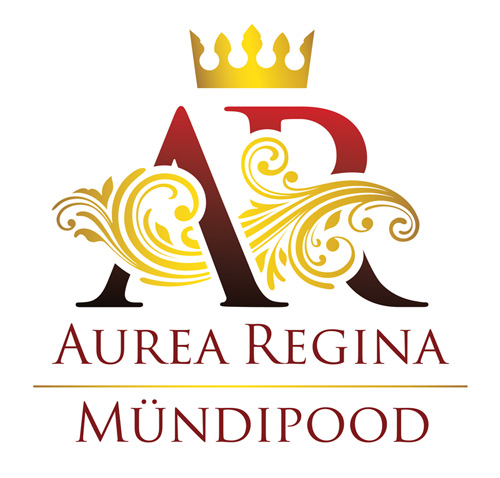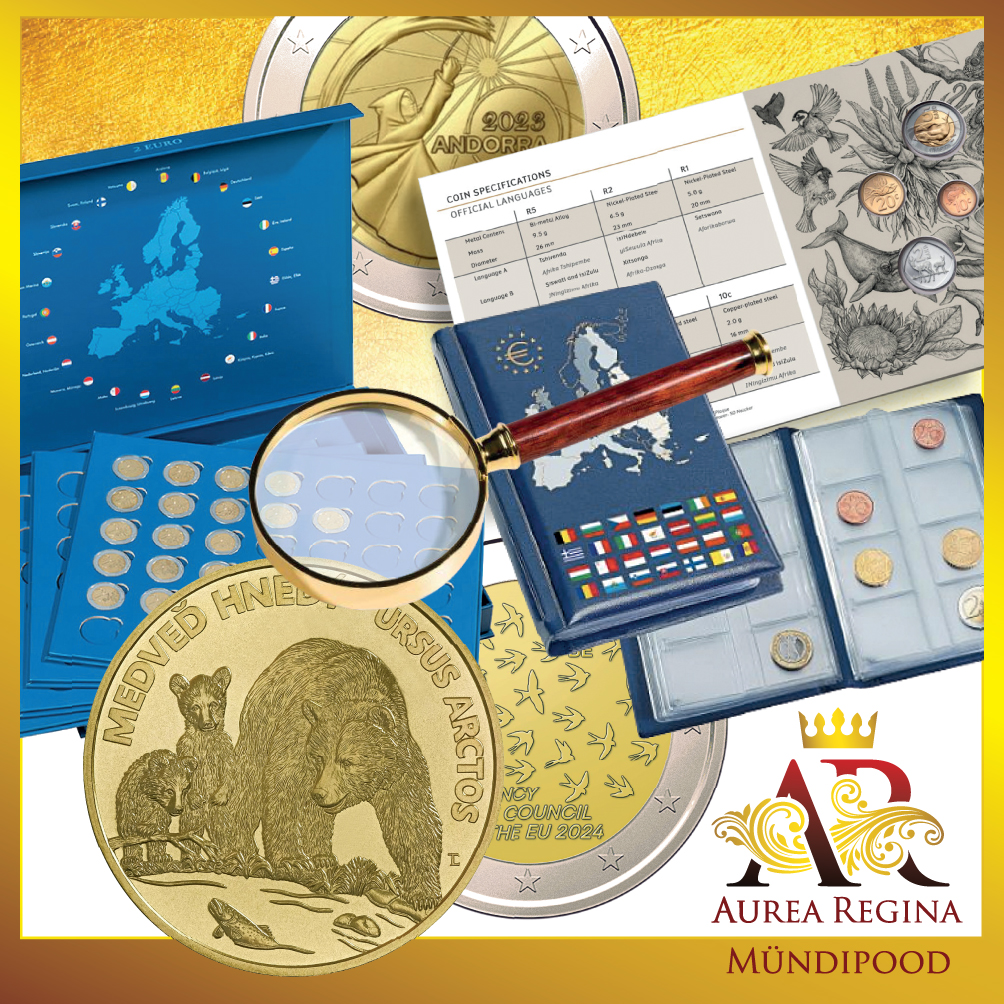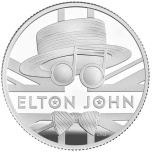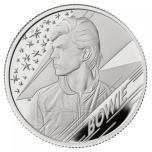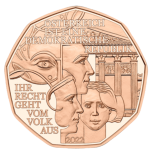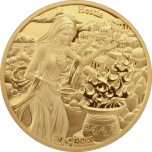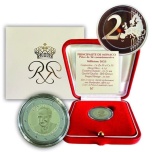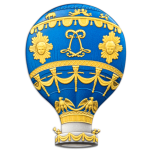Elton John - Music Legends United Kingdom 5£ 2020 Brilliant Uncirculated Coin
Price:
25,00 €
Denomination: £5
Maximum Coin Mintage; Unlimited
Alloy: Cupro-nickel
Weight: 28.28 g
Diameter: 38.61mm
Reverse Designer Chris Facey
Obverse Designer Jody Clark
Quality: Brilliant Uncirculated
Year: 2020
A delightful gift for fans of British pop music
Celebrates the incredible career of one of the bestselling British artists of all time
Features the first coin design inspired by Bradley Morgan Johnson Part of The Royal Mint's exciting Music Legends series
Finished to Brilliant Uncirculated standard
Maximum Coin Mintage; Unlimited
Alloy: Cupro-nickel
Weight: 28.28 g
Diameter: 38.61mm
Reverse Designer Chris Facey
Obverse Designer Jody Clark
Quality: Brilliant Uncirculated
Year: 2020
A delightful gift for fans of British pop music
Celebrates the incredible career of one of the bestselling British artists of all time
Features the first coin design inspired by Bradley Morgan Johnson Part of The Royal Mint's exciting Music Legends series
Finished to Brilliant Uncirculated standard
Kollektsioon
Denomination: £1
Maximum Coin Mintage: 15000
Fine Silver 99.9 %
Weight 15.71 g
Diameter: 27.00mm
Reverse Designer Bradley Morgan Johnson
Obverse Designer Jody Clark
Quality Proof
Year 2020
Celebrate one of the best selling British artists of all time
The only coin in the range displayed in a colour printed acrylic block
A Limited Edition Presentation of 14,000
Features the official portrait of Her Majesty The Queen on the coin's obverse
Struck in 999 fine silver and finished to Proof standard
Maximum Coin Mintage: 15000
Fine Silver 99.9 %
Weight 15.71 g
Diameter: 27.00mm
Reverse Designer Bradley Morgan Johnson
Obverse Designer Jody Clark
Quality Proof
Year 2020
Celebrate one of the best selling British artists of all time
The only coin in the range displayed in a colour printed acrylic block
A Limited Edition Presentation of 14,000
Features the official portrait of Her Majesty The Queen on the coin's obverse
Struck in 999 fine silver and finished to Proof standard
110,00 €
Denomination: £1
Maximum Coin Mintage: 15000
Fine Silver 99.9 %
Weight 15.71 g
Diameter: 27.00mm
Reverse Designer Bradley Morgan Johnson
Obverse Designer Jody Clark
Quality Proof
Year 2020
Born in Brixton, South London, in 1947, David Bowie began life as David Robert Jones. By the time he was 19 he had taken on his iconic name and was taking the first steps in one of the most innovative and influential careers in the history of sound and vision. His music electrified generations, and his perpetual state of reinvention kept music fans enthralled.
The third coin in our Music Legends collection celebrates rock’s definitive chameleon with a design inspired by an image of the singer from his time spent living and recording in Berlin. The inclusion of the lightning bolt motif from the Aladdin Sane era captures Bowie’s career journey, and the moment he finally put aside the props to emerge as an artist in his own right.
Available as limited-edition precious metal Proof editions and a standard Brilliant Uncirculated edition, the Brilliant Uncirculated edition is also available with three different slipcase covers, exclusively available from The Royal Mint and are a fitting tribute to the career of one of British music’s most enduring icons.
Maximum Coin Mintage: 15000
Fine Silver 99.9 %
Weight 15.71 g
Diameter: 27.00mm
Reverse Designer Bradley Morgan Johnson
Obverse Designer Jody Clark
Quality Proof
Year 2020
Born in Brixton, South London, in 1947, David Bowie began life as David Robert Jones. By the time he was 19 he had taken on his iconic name and was taking the first steps in one of the most innovative and influential careers in the history of sound and vision. His music electrified generations, and his perpetual state of reinvention kept music fans enthralled.
The third coin in our Music Legends collection celebrates rock’s definitive chameleon with a design inspired by an image of the singer from his time spent living and recording in Berlin. The inclusion of the lightning bolt motif from the Aladdin Sane era captures Bowie’s career journey, and the moment he finally put aside the props to emerge as an artist in his own right.
Available as limited-edition precious metal Proof editions and a standard Brilliant Uncirculated edition, the Brilliant Uncirculated edition is also available with three different slipcase covers, exclusively available from The Royal Mint and are a fitting tribute to the career of one of British music’s most enduring icons.
110,00 €
Similar products
Country: Tokelau
Year: 2019
Face Value: 1 Dollar x 3
Metal; Cupronickel
Weight: 26 g x 3
Diameter: 40 mm
Quality: Prooflike
Mintage: 5.000 pcs
Presentation case
This beautiful Gold plated coin Set is dedicated to one of the most famou novel written by English author Mary Shelley – Frankenstein. The coins have a beautiful colouration, have a wonderful Gold plating, have a Proof quality and come in an elegant presentation case, along with the Certificate of Authenticity. Limited mintage to 5.000 pieces worldwide.
Year: 2019
Face Value: 1 Dollar x 3
Metal; Cupronickel
Weight: 26 g x 3
Diameter: 40 mm
Quality: Prooflike
Mintage: 5.000 pcs
Presentation case
This beautiful Gold plated coin Set is dedicated to one of the most famou novel written by English author Mary Shelley – Frankenstein. The coins have a beautiful colouration, have a wonderful Gold plating, have a Proof quality and come in an elegant presentation case, along with the Certificate of Authenticity. Limited mintage to 5.000 pieces worldwide.
115,00 €
Quality: Uncirculated
Face Value: 5 Euro
Diameter: 28,5 mm
Material: Copper
Total Weight: 8,9 g
Mintage: 200 000
A coin the likes of which Austria has never seen before, Democracy is made from copper from the former roof of the Parliament building in Vienna. When you purchase the coin you therefore acquire a little piece of democracy and by spending 5 euros you get something priceless in return.
On the occasion of the reopening of the Parliament building in Vienna, we are issuing this very special coin. The copper it contains originally formed part of the former roof of the building but was removed during the ongoing renovation of the building. By using it to make the copper edition of the Democracy coin, we are making our democratic tradition something tangible. A strong democracy thrives on discourse. Our opinions may differ, but our consensus is democracy. Likewise, fundamental rights and freedoms make a democracy what it is. They enable individual and social freedom and guarantee the co-determination of the individual.
The coin’s reverse features two heads in profile and one full face, which represent the people as sovereign. To the left, we see a watchful eye surrounded by stylised laurel leaves, to the right, we see a section of the Austrian Parliament building in the background. But much more than this, the coin illustrates the spirit from which our nation was born. This is reflected in the Austrian Constitution, where it says: "Austria is a democratic republic. Its law emanates from the people." These wise words appear on the top and bottom edges of the coin.
Face Value: 5 Euro
Diameter: 28,5 mm
Material: Copper
Total Weight: 8,9 g
Mintage: 200 000
A coin the likes of which Austria has never seen before, Democracy is made from copper from the former roof of the Parliament building in Vienna. When you purchase the coin you therefore acquire a little piece of democracy and by spending 5 euros you get something priceless in return.
On the occasion of the reopening of the Parliament building in Vienna, we are issuing this very special coin. The copper it contains originally formed part of the former roof of the building but was removed during the ongoing renovation of the building. By using it to make the copper edition of the Democracy coin, we are making our democratic tradition something tangible. A strong democracy thrives on discourse. Our opinions may differ, but our consensus is democracy. Likewise, fundamental rights and freedoms make a democracy what it is. They enable individual and social freedom and guarantee the co-determination of the individual.
The coin’s reverse features two heads in profile and one full face, which represent the people as sovereign. To the left, we see a watchful eye surrounded by stylised laurel leaves, to the right, we see a section of the Austrian Parliament building in the background. But much more than this, the coin illustrates the spirit from which our nation was born. This is reflected in the Austrian Constitution, where it says: "Austria is a democratic republic. Its law emanates from the people." These wise words appear on the top and bottom edges of the coin.
15,00 €
Face value: 0.2 $
Issuing country: Samoa
Weight: 25 g
Diameter: 40 mm
Hestia's main sign if Capricorn, which stresses her more subtle but relevant nature. Capricorn, like Sagittarius, also stresses order, stability and stoicness. More so, it takes theses traits further and is a sign associated with practicality, hard work, strong will and stubbornness. Hestia, as the perpetual tender of the flames, is definitely a very hard working and practical goddess, and while I by no means would refer to her as “stubborn”, she does have a strong will in what little myths she appears in. Capricorn is also relevant in it’s role in the Zodiac. It’s the sign that covers the Winter Solstice, when the Sun is at it’s lowest, being opposite to Cancer. Thus, not only does it coincide with the time of the year where Hestia’s influence is most important, as well as to her role as the center, it also coincides with a liminal time in the Zodiac, when the Sun is reborn.
Issuing country: Samoa
Weight: 25 g
Diameter: 40 mm
Hestia's main sign if Capricorn, which stresses her more subtle but relevant nature. Capricorn, like Sagittarius, also stresses order, stability and stoicness. More so, it takes theses traits further and is a sign associated with practicality, hard work, strong will and stubbornness. Hestia, as the perpetual tender of the flames, is definitely a very hard working and practical goddess, and while I by no means would refer to her as “stubborn”, she does have a strong will in what little myths she appears in. Capricorn is also relevant in it’s role in the Zodiac. It’s the sign that covers the Winter Solstice, when the Sun is at it’s lowest, being opposite to Cancer. Thus, not only does it coincide with the time of the year where Hestia’s influence is most important, as well as to her role as the center, it also coincides with a liminal time in the Zodiac, when the Sun is reborn.
35,00 €
Feature: 100th Anniversary of the Birth of Rainier III
Description:
Issuing volume: 25 000 coins
Issuing date: 2023
Description:
Issuing volume: 25 000 coins
Issuing date: 2023
555,00 €
Country Burundi
Year 2023
Face Value: 25 Francs
Silver: 99,9%
Weight: 2 oz
Diameter: 45 x 65 mm
Quality: antique finish, Blue metallic laquer, gold colour print
Mintage: 1783 pcs
2 oz silver Hot air balloon with special finish.
On 4 June 1783 the Montgolfier brothers‘ first hot air balloon took to the skies in France. In November of the same year, the first manned hot air balloon flight followed, remaining in the air for 25 minutes.
This stunning 2 oz balloon-shaped coin with blue metallic lacquer and gold print is inspired by the appearance of the first hot air balloons.
Limited to 1,783 pieces. Be quick and secure your quantities of this beautifully detailed coin!
Year 2023
Face Value: 25 Francs
Silver: 99,9%
Weight: 2 oz
Diameter: 45 x 65 mm
Quality: antique finish, Blue metallic laquer, gold colour print
Mintage: 1783 pcs
2 oz silver Hot air balloon with special finish.
On 4 June 1783 the Montgolfier brothers‘ first hot air balloon took to the skies in France. In November of the same year, the first manned hot air balloon flight followed, remaining in the air for 25 minutes.
This stunning 2 oz balloon-shaped coin with blue metallic lacquer and gold print is inspired by the appearance of the first hot air balloons.
Limited to 1,783 pieces. Be quick and secure your quantities of this beautifully detailed coin!
229,00 €
